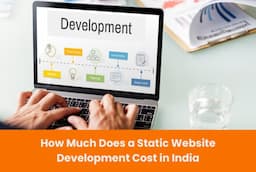7 Deciding Factors Affecting Your Website's Development Cost

Introduction:
Having a good online presence is essential for both individuals and organisations in the digital age. The foundation of this online presence is a well-thought-out and operational website. Still, depending on a number of variables, website construction costs can differ significantly. Making wise decisions and creating an efficient budget requires an understanding of these variables.
We'll look at seven important variables that have a big impact on website development costs in this post.
Top 7 Factors Affecting the Cost of Developing Your Website
Here are top 7 factors affecting the cost of developing your website:
1. Type of Website:
The type of website you need is a fundamental factor that influences development costs. Websites come in various forms, such as simple static websites, dynamic websites, e-commerce platforms, content management systems (CMS), and custom web applications. Each type requires different levels of complexity in terms of design, functionality, and features.
These are basic websites with fixed content and minimal interactivity. They are the least expensive to develop as they do not require complex databases or dynamic features.
Dynamic websites involve more advanced features, such as user interaction, real-time content updates, and database integration. These sites are more complex and, therefore, more expensive to develop.
Websites with online stores require additional functionalities like payment gateways, inventory management, and secure transactions. Developing an e-commerce platform is generally more costly due to these advanced features.
Content Management Systems (CMS):
CMS-based websites, like WordPress or Joomla, are popular for their ease of content management. While the development cost might be lower initially, ongoing maintenance and customization can add to the overall expenses.
Custom Web Applications:
Highly specialized websites or web applications tailored to specific business needs can be the most expensive to develop. These projects often require extensive planning, development, and testing phases.
2. Design Complexity:
The visual appeal and user experience of a website play a crucial role in its success. The complexity of the design, including the number of pages, unique features, and custom graphics, significantly impacts development costs.
Number of Pages:
A simple website with a few static pages will cost less than a complex website with numerous pages, each requiring unique designs and layouts.
Custom Graphics and Branding:
If your website requires custom graphics, logos, or branding elements, the cost will increase. Custom design work adds a unique touch to your site but can be more time-consuming and labor-intensive.
Responsive Design:
With the prevalence of mobile devices, having a responsive design that adapts to various screen sizes is essential. Implementing responsive design adds an extra layer of complexity to the development process, impacting costs.
3. Functionality and Features:
The functionality and features you want on your website significantly contribute to the overall development cost. Basic websites with standard features will be more affordable compared to websites with advanced functionalities.
User Authentication and Authorization:
If your website requires user accounts, login functionality, or different levels of access control, development costs will increase.
E-commerce Features:
Implementing e-commerce functionalities, such as product catalogs, shopping carts, and secure payment gateways, adds complexity and cost to the development process.
Third-party Integrations:
Integrating third-party services or APIs (Application Programming Interfaces) can enhance your website's functionality but may also increase development costs. Common integrations include social media, payment gateways, and analytics tools.
Custom Forms and Interactivity:
If your website includes custom forms, interactive elements, or real-time updates, the development effort will be higher, impacting costs accordingly.
4. Technology Stack:
The technology stack chosen for website development plays a significant role in determining costs. The selection of programming languages, frameworks, and tools can influence the development time, scalability, and overall performance of the website.
Open Source vs. Proprietary Solutions:
Using open-source technologies can be cost-effective, as they are freely available and have a large community of developers. Proprietary solutions, on the other hand, may involve licensing fees, impacting the overall development cost.
Content Management Systems (CMS):
Choosing a CMS like WordPress or Drupal can streamline development, but customization and additional features may require more resources and increase costs.
Programming Languages and Frameworks:
The choice of programming languages and frameworks can affect development speed and efficiency. Some languages and frameworks may have a steeper learning curve or require specialized expertise, impacting costs.
Scalability Requirements:
If your website needs to handle a large volume of traffic or data, scalability becomes a crucial consideration. Building a scalable architecture may require additional development effort and resources.
5. Testing and Quality Assurance:
Ensuring the functionality, security, and performance of a website is a critical step in the development process. Testing and quality assurance efforts can vary based on the complexity of the website and its features.
Functionality Testing:
Testing the website's features and functionalities to ensure they work as intended is a standard practice. Complex websites with intricate features may require more extensive testing, contributing to higher costs.
Security Testing:
Websites, especially those dealing with user data or transactions, require robust security measures. Implementing security testing tools and conducting thorough security assessments can increase development costs.
Performance Optimization:
Optimizing a website for speed and performance is essential for providing a seamless user experience. This process may involve code optimization, image compression, and other performance-enhancing techniques, adding to development costs.
Cross-Browser and Cross-Device Testing:
Ensuring that the website functions correctly across various browsers and devices is crucial. Testing on multiple platforms can increase testing time and costs.
6. Project Management and Communication:
Effective project management and clear communication are vital for the successful development of a website. The level of project management and communication required can influence development costs.
Project Complexity:
Complex projects with multiple stakeholders, frequent changes in requirements, or intricate development processes may require more extensive project management efforts, increasing costs.
Client Involvement:
The level of client involvement in the development process can impact costs. Regular communication, feedback, and timely decision-making contribute to efficient development, while frequent changes or delays may extend the timeline and increase expenses.
Agile vs. Waterfall Development:
The choice of development methodology, such as Agile or Waterfall, can influence project management costs. Agile methodologies allow for more flexibility and adaptation to changes but may require more frequent communication and collaboration.
7. Ongoing Maintenance and Support:
The development cost of a website extends beyond the initial build. Ongoing maintenance, updates, and support are essential for keeping the website secure, functional, and up-to-date.
Content Updates and Maintenance:
Regularly updating content, images, and other elements of the website to keep it relevant requires ongoing effort. The frequency and complexity of updates can impact maintenance costs.
Security Updates and Patches:
With the ever-evolving landscape of cybersecurity threats, regular security updates and patches are crucial. Implementing these updates and ensuring the website remains secure contribute to ongoing maintenance costs.
Technical Support:
Providing technical support to address user issues, troubleshoot problems, and implement changes adds to the overall cost. The level of support required depends on the complexity of the website and its user base.
Conclusion:
In summary, website development cost in India are a complex issue that is influenced by a number of variables. Knowing these elements enables companies and people to plan their finances wisely, make wise decisions, and guarantee the growth of their online presence. Stakeholders may more easily and efficiently navigate the development process by carefully evaluating the kind of website, design complexity, necessary functionality, technological stack, testing and quality assurance, project management, and continuing maintenance. Investing in a well-designed website is ultimately an investment in the visibility and success of any online business.
Recent Blogs

Key Benefits of Hiring Website Development Services in India

Hire One Stop Shop Web Design Company for Complete Website Solutions
